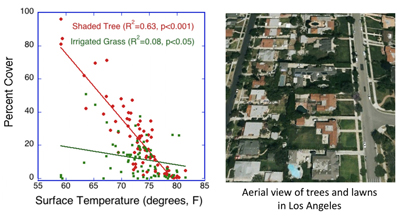Urban heat island (UHI) refers to the characteristic warming of urban areas compared to their rural surroundings as a result of changes of surface and atmospheric conditions from urbanization (expansion of buildings, roads, pollution, energy use, etc.). UHI is an inadvertent climate change that arises from changes to surface radiation and energy balance and reduction of cooling rates in urban areas. The effect is attributed to the large expansion of non-evaporative impervious material covering large urban areas with consequence of an increase in sensible heat flux and decrease in latent heat flux ((Voogt & Oke, 2003). UHI has significant implications for human comfort and health, urban air pollution, energy management, and urban planning. In cities located in hot climates, UHI causes higher cooling loads and energy use with increased human discomfort. In temperate and cold climates, heat island may provide some benefits especially in winter by reducing heating load.
In Los Angeles, the semi-arid landscape, warm climate, and topographically complex terrain, the urban heat island can be a major concern for urban planning and water and energy use management. Over-population, urban sprawl, concentrated pollutions, and anthropogenic heat generated by traffic, industry, and domestic buildings are other effects exacerbating the UHI in Los Angeles (Figure 1).

